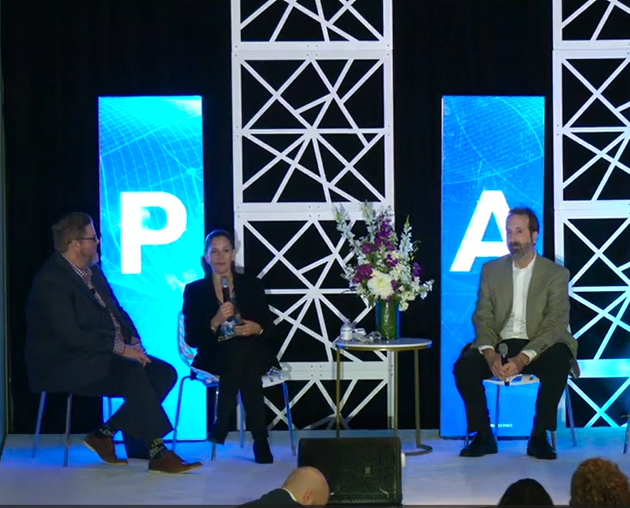Charity may begin at home, but it needs organizations to boost patient access to care

A discussion at Access USA tackled the complexities of patient expenses and how nonprofit charitable organizations provide a safety net for Americans.
Alan Klein, chief growth and strategy officer of the PAN Foundation, and Kelly Green, executive director of Health Hope Live, took the stage with moderator Jonathan James, CEO of Hope Charities, to discuss the organizations’ missions, models, and limitations in a room of professionals dedicated to the patient assistance program function.
 From left to right, Jonathan James, Kelly Green and Alan Klein.
From left to right, Jonathan James, Kelly Green and Alan Klein.
Klein opened his remarks to that room, “We are all here to make sure that the patient gets his or her medicine as prescribed with as much ease and as little pushback as is possible.”
He then laid out PAN’s model, which typically involves providing co-pay assistance and premium support for patients who meet specific eligibility criteria, as well as providing education and advocacy. Looking at the current landscape, which involves recent reforms like the IRA that have helped reduce some prescription drug costs, Klein emphasized that the need for assistance remains critical. “Not everybody can afford $2,000 or more out of pocket. People who are retired, of course, are on fixed income ... That $2,000 is a big deal that could be up to a month's take-home pay. That is not acceptable."
In contrast, Help Hope Live takes a broader, more holistic approach to patient assistance. Green described its unique model: “We are the nation’s only charitable platform for medical fundraising, and we offer grants. Anybody who comes to us has to fit a certain model. We have to verify they have a condition that we serve, which is any kind of catastrophic condition.”
Unlike the PAN Foundation’s focus on medication costs, Help Hope Live addresses a wider range of medical-related expenses. Green explained, “We cover the co-pays, the deductibles, the retrofitting of homes, wheelchair accessible vehicles, experimental treatments, and we guide them along a process that is pretty complex and quite scary.”
Funding models
One key difference between the two organizations is their funding model. While the PAN Foundation relies heavily on donations from pharmaceutical companies and other stakeholders, Help Hope Live empowers patients to engage in their own fundraising efforts. Green described this as a “mutual responsibility” approach: “We’re going to activate communities of support. We’re going to bring them together so that you’re not in this alone.” Basically, all fundraising goes into the charity.
And that is because of what may be a little-known fact: a Go Fund Me is deposited directly into a bank account and becomes taxable income and an asset. “When that happens, it potentially eliminates the ability to rely on asset-based resources like Medicaid and Medicare,” Green said.
“We help them along this journey and ensure that they don’t lose those supports, because all the funds come from the charity. Charity then pays bills directly to vendors. There is no funding that is given directly to an individual, we just cover their needs. So in that case, it’s not their reportable income, it’s not their tax burden, and they don't lose their government support, which is a paltry little safety net, but it's kind of all we have.”
Despite their different methodologies, both organizations share a common challenge: the overwhelming demand for their services. Klein pointed out that even with their substantial reach, the PAN Foundation can typically only help “1% to 2% of the US patient population in a disease area.” Green echoed this sentiment, stating bluntly, “Far from enough support.”
Additional support
Both organizations also go beyond just financial assistance, recognizing the need for comprehensive support in navigating the healthcare system. Klein highlighted PAN Foundation’s efforts in advocacy and education: “We basically have to marshal everything that we do best in order to make sure that healthcare is as close to a right as it can be, until it actually becomes such.”
Similarly, Green emphasized Help Hope Live’s commitment to long-term support: “Once we accept them in the program, they’re with us for life. We don’t charge anything for what we do, we make sure that they have access to everything that they want and need for their medical condition that isn’t covered by insurance.”
Looking to the future, both organizations are bracing for increasing challenges. Green noted, “We’re seeing more and more fear, given the current administration and the potential cuts that are coming down the line, the tariffs that are going into effect ... We are already anticipating tripling the cost for, say, titanium, which are part of prosthetics, or cobalt, which is in some of the stents.”
Klein, meanwhile, is seeing a trend where individual donations are diminishing, and that donor-advised funds, foundation giving, and corporate giving is up. “We’re trying to shift our model so that we can help people to focus more on what’s working.” However, he maintains that the majority of their money still comes from individual donors and foundations.
Green summed up the ultimate goal of both organizations: “We want to level that playing field so that everybody has access to everything that they need.” In a world where healthcare remains a privilege rather than a right, PAN Foundation and Help Hope Live are working to bridge the gap one patient at a time.
Quotes lightly edited for clarity.
Lead image credit, Depositphotos@ilixe48